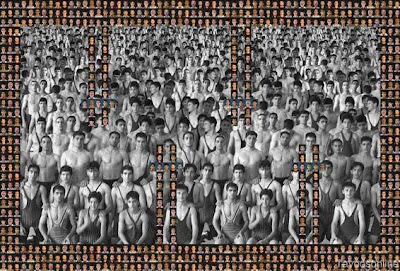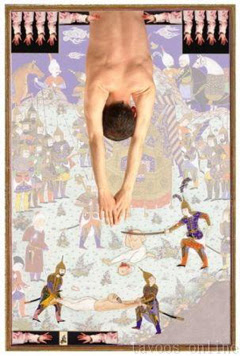Sadeq Tirafkan and his art
Tr. by Roya Monajem, Tavoos Art Magazine
Note: In writing this article, Tirafkan’s interviews with Canvas (Art and Culture from the Middle East & Arab World, Vol.3, 2009), and Asian Art News (Vol.18, 2008), his own comments for his various exhibitions stated in the corresponding catalogues have been the sources of inspiration.
Sadegh Tirafkan was born in Karbala, Iraq to Iranian parents in 1965, and like all Iranian families in Iraq at that time, they were expelled by Saddam Hussein in 1971. So they fled to Iran just before the Islamic revolution. From 15 to 18, Tirafkan became a member of the youth militia, basij and participated in Iran-Iraq war in 1980s. The experience left such a deep impression on him that still reverberates in his work. In an interview with Canvas, while showing his snapshots of those years, he says: “Most of these people are dead now and I have lost touch with the others.” HisAshura ongoing series originates from these years of his direct religious experience, when he also made his mind to pursue an artistic career and subsequently entered Tehran University and was graduated in 1989 with a degree in photography. “I began photography by recording what surrounded me, now I take what is around me into the studio and make it into what I see through the prism of my life and culture. An idea starts as photograph, but it may grow into a collage or video.” His simultaneous deep interest in theater and film, frequently makes his work appear as a combination of a staged theatricality (even when he has not actually staged the photo) with a documentarian’s eye, revealing the influence of Cindy Sherman on him. Like her, Tirafkan uses self-portraiture to fulfill narrative ends, but where Sherman adopts various disguises in her photos, he is nearly always recognisable.
“I like the precision and aesthetic of a staged photo and strive for that without actually staging it.” Other influences include Philip Lorca di Corcia and Vik Muniz. Tirafkan is continually absorbing and learning from all around and, as he says, “I’m always a student.”
To some extent this explains Tirafakan’s spontaneous approach to his projects. He constantly works on simultaneous projects and never begins them as a work in isolation with determined start and end date.
Thematic variations consistently weave in and out of Sadegh Tirafkan’s work - Iranian culture, contemporary culture, ancient culture and his identity as a man and as an Iranian. In his photography and videos, Tirafkan draws from the vast several thousand-year-old history of Iran, from the Zoroastrian religion and the Safavid Dynasty to the present, including satellite television and celebrity culture. He subsequently adds layers of his own personal experience to create a rich tapestry of expertly crafted aesthetics and concepts.
Tirafkan is a genial man with salt-and-pepper hair, expressive hands and a quick smile. His boyish looks and energetic demeanour reveal the mature voice of a man who has witnessed a lot in his 44 years.”
He had his first solo exhibition of portraits at Seyhoun Gallery in Tehran, in 1990. In the November of the same year he was invited to participate in Mois de photographie held in Paris. This marked the beginning of his career outside Iran and became the impetus for his move to New York in 1997, where the interaction with Western artists strengthened his belief in his Iranian-ness, bringing him back to Iran to produce the first conceptual video installation produced in Iran, called Persepolis exhibited at Seyhoun Gallery in 1998.
In an interview with Janet Rady from Asian Art News, in reply to her question, why he used Persepolis as a backdrop for images of himself, he exclaims: “... The question of identity of self and of nationality has always fascinated me. The glory and grandeur of any civilization is reflected in the monuments left behind and by picturing myself, I wanted to better understand what it was that the monument exuded both on a personal level and on a national one.”
While in Iran, he becomes more interested in Pre-Islamic and Islamic cultures, including art, philosophy and literature, giving rise to his series of Choghazanbil (an ancient ziggurat in southwest Iran 1995-1998) and Ashura (the mourning ceremony of martyrdom of the third Shiite Imam Hussein (1989-2004) and Persepolis 2 series in 2002 in which he introduced other people from different historical settings into the frame.
Beginning to shoot with a Hasselblad camera, which captures incredibly rich and detailed images, Tirafkan switched to a portable digital format in 2002. That’s why the Ashura series, consists of snapshots which are sometimes the final work of art and at other times, they serve as a preparatory image that the artist then manipulates on a computer. Within the theme of Ashura, Tirafkan has many subcategories, including fashion, generation and gender. The fashion component resulted in the Men in Black series. The first part of Ashura was exhibited at Tehran Museum of Contemporary Arts in 2001. A part of Men in Black first appeared in a book published in 2005, and later exhibited at Waterhouse & Dodd Fine Art in 2008. Altogether according to his own estimate only five percent of the series has been seen by the public, something he hopes to change by publishing a book of all the images in the future.
In 2002 he turns to calligraphy which he considers as “the highest written form of communication for all mankind,” and his Secrets of Words is born, featured in Whispered Secrets, Murmuring Dreams, a group exhibition held in London in 2008. “We all have our sad stories, which we instantly recognize in the glimpse of another. So, the single letters in my work act as a metaphor for these glimpses and set out to show that through our feeling-experiences, we all share something in common.”
In addition to Iranian history and self-identity, masculinity and manhood has been a major subject matter of Tirafkan’s works, dealt with first in Iranian Men (2000) which was later published in Belgium in 2006. A self-portrait photo triptych resembling a sequential comic strip, masking his identity under a red lo-ng, a traditional Iranian sash (originally made of gold and silk threads) used in sporting combats that is known as the warrior wearing symbol of masculinity and according to Tirafkan “of humanity of real man not just in Iran, but in universal society today. In fact, the subject of masculinity is continued in my current series The Loss of Identity.”
“I tried to convey the humanistic message embedded in these ancient symbols of manhood in my culture - lest they are forgotten.
In Zoorkhaneh (2003-4)which is Islamized Mithraic temples where ever since then men made their body as well as their mind, and has been the cradle of many orders of knighthood and other masculine cults, Tirafkan tries to show that although ‘the same environment and looks are kept, but not the same spirit and attitude.
No wonder that his other simultaneous project, Sacrifice (2003) video is set in a zoorkhaneh, where the red lo-ng wearing wrestlers tumble about center stage.
But just underneath the surface, crimes of passion clash with hidden affairs and madness dances with rage. This is where Tirafkan challenges the taboos of traditional Iranian culture. Inspired by the stories of Abraham nearly killing his favorite son to prove his devotion to God, Rostam, the most well-known ancient Iranian knight unknowingly killing his sole son to prove his devotion to his king and country and Imam Hussein as the classical Shiite emblem of self-sacrifice for one’s faith and ideology, Tirafkan describes this series as “my artistic interpretation of the emotional impact these stories have had on me since childhood.” Later he develops the same theme further in Devotion.
For Tirafkan symbols “have their own values and meaning in every culture,’ while “basic human instincts have common meanings for people all over the world.” To him “pomegranate is the most symbolic fruit in middle east,” covering a wide scope of meanings from love to infinite world and in Temptation dedicated to his favorite filmmaker Sergei Parajanov, he “leaves the audience to interpret it in their own way.”
In Body Signs, Body Curves and Loss of Our Identity, Tirafkan approaches culture as a physical stamp that cannot be removed or altered, thus making a great part of one’s identity. The imagery in these series was inspired by ancient Iranian tattooing practiced among pre-Achaemenid kings, as well as by wooden block print stamps used to decorate cloth. But for Tirafkan, “the blocks have been used here to stamp the human form. Flesh is the canvas branded by culture.”
From another perspective, this series can be viewed as the artist’s lamentation for former glories of Iranian culture now being replaced by contemporary Iranian youth with “the present commercial pervasive satellite broadcasts and the Internet.” As Tirafkan so aptly states, “The first thing war kills is culture. Governments cut budgets for culture but have the means for the satellites that beam garbage directly into peoples’ homes.” The role of cultural heritage in contemporary life is another ongoing subject, Tirafkan deal with in Multitude and Devotion exhibited at Assar Gallery in Tehran in 2008. Both series deal with the leitmotifs of identity and culture.
Multitude looks to a person’s public life and the crowded streets of Tehran one must negotiate when leaving one’s home, taking the initial documentary snapshots of multigenerational group of men sitting on a hillside and transforming them into a work of art by manipulating the hillside into a rich and complex surface of dirt and an earth-toned Safavid carpet. Devotion which is more reserved and contemplative, comprises a series of a sequence of photos of men and women applied to the four walls of the gallery; in the centre is a glowing yellow-and-green glass a ziggurat-like construction referring to Iran’s Zoroastrian past. This sober work is more understated than his previous projects and also incorporates elements of installation art, which is new for the artist, who hopes to develop this project and exhibit it elsewhere.
Whispers of the East (2006-7) deals with the question of democracy and how US has little sensitivity for culture, religion and life style in the region, but is only concerned about military actions. With his interpretation of a classic Persian carpet, Tirafkan seeks to preserve the traditions.
His most recent project, Human Tapestry is a commemoration of the traditional art and unknown artists of his homeland to tie traditional beliefs and ancient patterns to modern people and contemporary aesthetics. “From 2006 I have been focusing on population and its unbalanced distribution around the world within my works.
I don’t only look at topic from a political aspect, but also and most importantly from an artistic eye - an eye which originates from a thousand year old culture, rich with history and civilization. I have been trying to combine current events with layered and hidden historical art, using new technology in order to ease communication between people living in today’s world and my work.”
As his body of work elucidates, Tirafkan is very proud of his identity as an Iranian man. He conveys this pride through meticulous art in which every detail is weighed and measured in order to create work that is to the best of his ability. He sees this as the ultimate Iranian cultural trait. “Iranian art reflects a heightened sense of perfectionism. Look at Persepolis, Iranian miniatures and Safavid art!”
Tirafkan’s richly layered art is the work of an incredibly complex man who has been to hell and back and whose work is fearless and poignant.
Perhaps his art is a poetic way to exorcise demons of the past and present.
My goal is to demonstrate that all people regardless of gender, culture and religion are indeed looking for inner peace and sanctity.
Via Peyvand









No comments:
Post a Comment